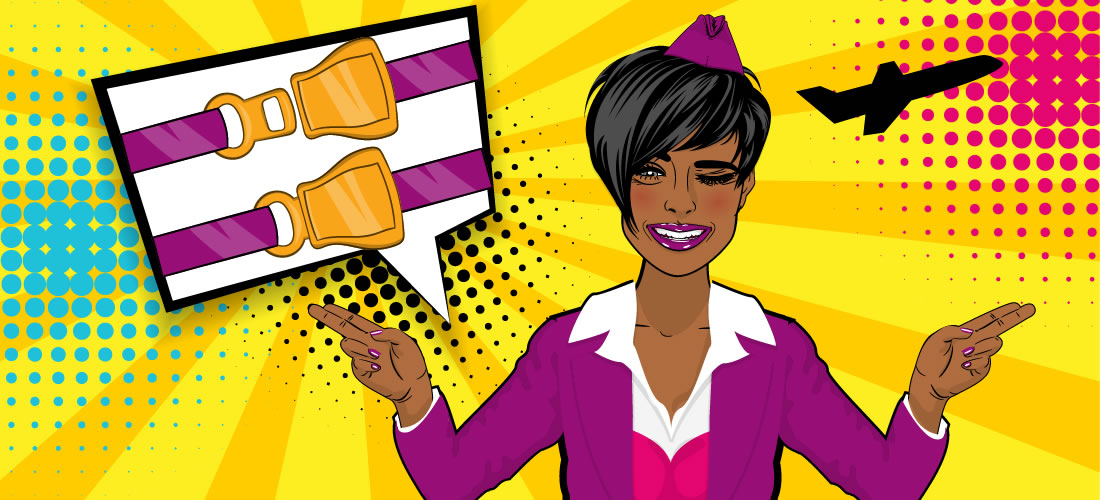How many of you really watch the airplane safety video? For the last few years, I can honestly say I’ve watched them a bunch. And, no, I’m not a nervous flyer. It’s because airlines have changed the game to make me and thousands of other passengers want to watch them. Their storytelling abilities have been on point, making these videos really fun to watch. Yes, really! I’m not the only one with this opinion either. Many have taken notice. The New York Times shared their top five videos last year, and they are worth your time, I promise.
One of the early innovators in this space was Virgin America in 2007. Because it’s a highly regulated industry, this was one of the few areas airlines could differentiate themselves and get bored customers to pay attention.
And then in 2008, Delta’s safety video clip was the first of its kind to achieve viral status. Featuring the lead flight attendant and her theatrical “no smoking” finger wag, this video achieved 300,000 views in one month on YouTube and was dubbed “Deltalina.” Remember her?

Side note, she became a bit of a celebrity with passengers and crew. I remember a friend who flew on a flight she worked. He told the story like he had flown with the highest-paid movie star.
The Three Keys to Successful Storytelling
As I look at these standout safety videos, there are three components making these videos successful in their storytelling:
- Humor
- Creativity
- Relevance
These three components are also the keys to success for any great story – and you should definitely incorporate them into your storytelling to engage your employees and customers. And I’m not talking about videos only. These elements apply to all types of storytelling. Let’s explore these in more detail.
Humor
Southwest Airlines is the most well-known airline for adding humor to their safety talks. Remember the rapping flight attendant? Humor makes difficult, even scary, content easier to digest. It makes a message easy to remember.
Now, using humor can be a little tricky, especially with a serious topic like safety. The reason it’s working for the airline industry so far is because they’re striking the right balance of humor and information. These videos are making you smile or chuckle, not roar with laughter.
As you consider using humor in your storytelling, seek the right balance by vetting stories with colleagues and end users before launching. Also, be sure to consider cultural nuances, as something clever and cheeky in one place can be offensive in another part of the world.
Creativity
Early on, most airline safety videos took place on a real plane, using real seats, lights, aisles, etc. Then, airlines removed the walls, showing seats and exit doors in large open warehouse spaces, and even having office chairs roll into the scene to represent an airplane. In one vignette, American Airlines even went away from an actual seatbelt, using painted arms to hold the passenger in his seat instead.
Creativity can also mean delivering the unexpected. In the airline examples, it’s opening an overhead bin to see a rainbow stowed there and travelers pulling luggage on what looks like a floor, but then the camera flips, and we see they are walking on a wall. Or when stacks of monochromatic luggage on carts are rolled across the screen and stop in a position that creates the American Airlines’ logo.
Safety videos had no storytelling, and now they are a successful vehicle for engaging customers. Airlines also took it up a notch by being creative about where they are creative – in a place you would never expect (it’s a bit meta, I know). How can you rethink your message and present it in a unique, unexpected way?
Relevance
Most safety videos today, when they don’t cast celebrities, feature employees. When employees – regardless of the industry – see actors portraying them on screen, it is easy for them to dismiss the message as inaccurate and inauthentic. But when the people in your story are the ones living the role on and off screen, people connect in a different way – an emotional way. People can see themselves in the story. They picture themselves and other real people on that plane. And yes, these employees won’t be perfect on screen, and that’s OK. That’s the point, actually. No one is perfect. Seeing someone do the job in a way that is authentic, where they make it their own, is compelling.
The airline safety videos also connect with what’s happening in the world around us. They reference top movies (see New Zealand’s nod to The Lord of the Rings), pop culture phenomena (see Delta’s nod to internet memes), and famous locals (see British Airways featuring Sir Ian McKellan and Mr. Bean. Cool thing about the British Airways video: it was produced in partnership with Comic Relief, British Airways’ charity partner, to raise awareness for the charitable work they are doing together.).
All this, and they still achieve their primary objective – to train passengers on the safety features of the plane. And with more relevant storytelling, they are accomplishing that more effectively.
What are the current, relevant connections you can make between the world we are living in and your message? How can you showcase the real people who are the lifeblood of your business?
Storytelling Inspo Can Be Anywhere – Even Up in the Clouds
I’m a firm believer in learning from where you are and what you are seeing day to day. Case in point, I spend many hours a week on airplanes, so my learning happens there more than I realized. And, I’m truly inspired by what airlines are doing today in their engagement of customers and employees in their safety videos. Where can you integrate humor, creativity, and relevance in your stories? Send me a note with your favorite airline safety video!






